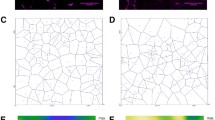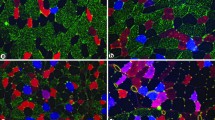Summary
Biopsies from the medial gastrocnemius muscle of three experienced endurance runners who had completed an ultramarathon run (160 km) the previous day were assessed for their oxidative characteristics (fibre types, capillarization and mitochondria content). Also, a regional comparison was made for fibres located centrally (completely surrounded by other fibres) versus fibres located peripherally (next to the interfascicular space) and the capillarization of these peripheral fibres was determined. Subsarcolemmal mitochondria were abundant and ‘compartmentalized’ close to the capillaries. The number of capillaries around fibres ranged from 5.8 to 8.5 and 5.7 to 8.5, and the number of capillaries·mm−2 ranged from 665 to 810 and 727 to 762, for type I (slow twitch) and type 11 (fast twitch) fibres, respectively. Central fibres contained a greater number of capillaries and more capillaries·mm−2 than their peripheral counterparts. Peripheral fibres contained more capillaries · μm−1 between fibres than at the interfascicular space. Type I fibres were more distributed (63%–78%) and larger than type II fibres. An abundance of subsarcolemmal mitochondria located close to the capillaries, efficient capillary proliferation between fibres where sharing can occur and greater relative distribution and size of type I fibres are, collectively, efficient characteristics of extreme endurance training.
Similar content being viewed by others
References
Andersen P (1975) Capillary density in skeletal muscle of man. Acta Physiol Scand 95:203–205
Andersen P, Henriksson J (1977a) Training induced changes in the subgroups of human type II skeletal muscle fibres. Acta Physiol Scand 99:123–125
Andersen P, Henriksson J (1977b) Capillary supply of the quadriceps femoris muscle of man: adaptive response to exercise. J Physiol 270:677–690
Andersen P, Kroese AJ (1978) Capillary supply in soleus and gastrocnemius muscles of man. Pflugers Arch 375:245–249
Bergström J (1962) Muscle electrolytes in man. Scand J Clin Lab Invest [Suppl] 68:1–110
Brodal P, Ingjer F, Hermansen L (1977) Capillary supply of skeletal muscle fibres in untrained and endurance-trained men. Am J Physiol 232:H705-H712
Brook MH, Kaiser KK (1970) Muscle fibre types: how many and what kind? Arch Neurol Psychiatry (Chicago) 23:369–379
Costill DL, Jansson E, Gollnick PD, Saltin B (1974) Glycogen utilization in leg muscles of men during level and uphill running. Acta Physiol Scand 91:475–481
Costill DL, Daniels J, Evans W, Fink W, Krahenbuhl G, Saltin B (1976a) Skeletal muscle enzymes and fibre composition in male and female track athletes. J Appl Physiol 40:149–154
Costill DL, Fink WJ, Pollock ML (1976b) Muscle fiber composition and enzyme activities of elite distance runners. Med Sci Sports 8:96–100
Costill DL, Fink WJ, Flynn M, Kirwan J (1987) Muscle fiber composition and enzyme activities in elite female distance runners. Int J Sports Med 8:103–106
Dubowitz V (1985) Histological and histochemical stains and reactions. In: Dubowitz V (ed) Muscle biopsy: a practical approach. Baillière Tindall, London, pp 34–102
Edgerton VR, Smith JL, Simpson DR (1975) Muscle fibre type populations of human leg muscles. Histochem J 7:259–266
Edström L, Nyström B (1969) Histochemical types and sizes of fibers of normal human muscles. Acta Neurol Scand 45:257–269
Gollnick PD, Armstrong RB, Saubert CW, Piehl K, Saltin B (1972) Enzyme activity and fiber composition in skeletal muscle of untrained and trained men. J Appl Physiol 33:312–319
Gollnick PD, Armstrong RB, Saltin B, Saubert CW, Sembrowich WL, Shephed RE (1973) Effect of training on enzyme activity and fiber composition on human skeletal muscle. J Appl Physiol 34:107–111
Hermansen L, Wachtlova M (1971) Capillary density of skeletal muscle in well-trained and untrained men. J Appl Physiol 30:860–863
Hoppeler H, Lüthi P, Claassen H, Weibel ER, Howald H (1973) The ultrastructure of the normal human skeletal muscle: a morphometric analysis on untrained men, women and welltrained orienteers. Pflugers Arch 344:217–232
Ingjer F (1979a) Capillary supply and mitochondrial content of different skeletal muscle fiber types in untrained and endurance-trained men. A histochemical and ultrastructural study. Eur J Appl Physiol 40:197–209
Ingjer F (1979b) Effects of endurance training on muscle fiber ATP-ase activity, capillary supply and mitochondrial content in man. J Physiol 294:419–432
Jansson E, Kaijser L (1977) Muscle adaptation to extreme endurance training in man. Acta Physiol Scand 100:315–324
Johnson MA, Polgar J, Weightman D, Appleton D (1973) Data on distribution of fibre types in thirty six human muscles. An autopsy study. J Neurol Sci 18:111–129
Kiessling KH, Piehl K, Lundquist CG (1971) Effect of physical training on ultrastructural features in human skeletal muscle. In: Pernow B, Saltin B (eds) Muscle metabolism during exercise. Plenum Press, New York, pp 97–101
Krogh A (1919) The number and distribution of capillaries in muscles with calculations of the oxygen pressure head necessary for supplying the tissue. J Physiol 52:409–415
Nygaard E (1976) Adaptational changes in human skeletal muscle with different levels of physical activity. Acta Physiol Scand [Suppl 440] 291:176–176
Nyström B (1968) Histochemistry of developing cat muscles. Acta Neurol Scand 44:405–439
Polgar J, Johnson MA, Weightman D, Appleton D (1973) Data on fibre size in thirty-six human muscles. An autopsy study. J Neurol Sci 19:307–318
Saltin B (1973) Metabolic fundamentals in exercise. Med Sci Sports 5:137–146
Saltin B, Henriksson J, Nygaard E, Andersen P, Jansson E (1977) Fiber types and metabolic potentials of skeletal muscles in sedentary man and endurance runners. The marathon: physiological, medical, epidemiological and psychological studies. Ann NY Acad Sci 301:3–27
Schantz P, Henriksson J, Jansson E (1983) Adaptation of human skeletal muscle to endurance training of long duration. Clin Physiol 3:141–151
Sjöström M, Friden J, Ekblom B (1987) Endurance, what is it? Muscle morphology after an extremely long distance run. Acta Physiol Scand 130:513–520
STSC Inc. (1987) Statgraphics User's Guide, STSC Inc., Maryland
Sternberger LA (1979) Immunocytochemistry. Wiley Medical, New York
Author information
Authors and Affiliations
Rights and permissions
About this article
Cite this article
Crenshaw, A.G., Fridén, J., Thornell, LE. et al. Extreme endurance training evidence of capillary and mitochondria compartmentalization in human skeletal muscle. Eur J Appl Physiol 63, 173–178 (1991). https://doi.org/10.1007/BF00233843
Accepted:
Issue Date:
DOI: https://doi.org/10.1007/BF00233843




